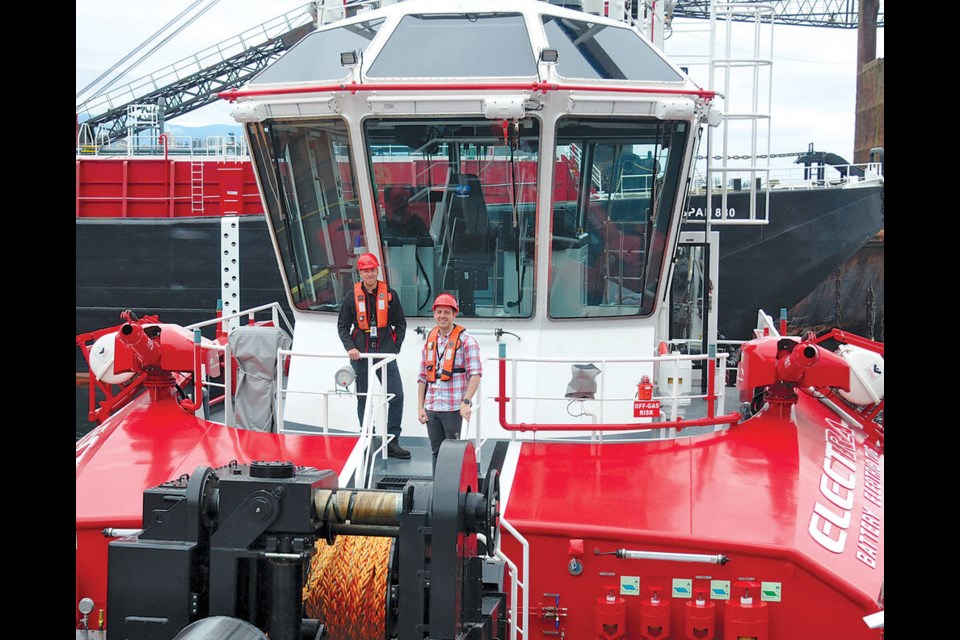It’s got enough power to push around an LNG tanker weighing close to 100,000 tonnes, but it doesn’t emit a whiff of carbon.
HaiSea Marine, a partnership between the Haisla Nation and North Vancouver’s Seaspan, has launched HaiSea Wamis, the world’s first all-electric tugboat.
“This will live its entire life on a zero emissions platform,” said Jordan Pechie, senior vice-president of Seaspan Marine Transportation. “It will change the game, for sure.”
In their negotiations over the approval of LNG Canada’s export terminal, it was the Haisla Nation leadership that insisted the project have the least environmental impact possible, including the possibility of a zero-emission tugboat. Seaspan sought out naval architecture firm Robert Allan Ltd. to do the design and had the HaiSea Wamis build at a Turkish shipyard, where almost all of the world’s tugs are produced because of local expertise.
(Yes, Seaspan also owns a major shipyard in North Vancouver but it is fully booked for the years ahead making vessels under Canada’s National Shipbuilding Strategy.)
The name was chosen through a contest held by the Haisla Nation, which wanted to the tug to honour Wamis, who, in their creation story, was their first ancestor to settle in what is now Kitimat.
HaiSea Wamis made its first public appearance as part of a ceremony in July, sailing under Lions Gate Bridge.
Until the LNG Canada terminal is ready for tankers, HaiSea Wamis will be put to work helping ships dock in the Vancouver harbour.
The surest way to spot HaiSea Wamis is to look for the tug that doesn’t have two massive smokestacks flanking the wheelhouse and belching out diesel exhaust. With those out of the picture, the tug’s masters quickly found visibility from the HaiSea Wamis unlike any other tug on the water, Pechie said.
“Visibility is everything,” he said. “Especially when you’re ship docking, you need to see all points of contact, you need to see your crew, you need to see the lines.”
The captains have also had to adjust to the almost instant torque that electric motors provide, making the vessel far more responsive than what they’re used to, so much so that the throttle has been designed to ease power up slowly.
Inside, it’s still got that new tugboat smell. The quarters have four cozy but private bedrooms and bathrooms, where crew members, many of whom are Haisla Nation members, will stay when they are on shift.
Below deck, there are six massive banks of 5,300 kilowatt hour Corvus batteries – about the equivalent of 70 top-of-the-line Teslas running full time. The electric drive system boasts about 7,000 horsepower, but with a 1,000- to 1,500-tonne reduction in greenhouse gas emission.
And Pechie said it should produce about 33 per cent less underwater noise compared to a diesel engine, making it a friendlier system for marine life.
The capital cost for the world’s first all-electric tug is higher up front, Pechie conceded, but the operational cost is much lower, with the break-even point coming after eight years, although Pechie added, other electric tugs designed for different tasks may reduce that number. And wear-and-tear and maintenance costs for their motors should be a fraction of their diesel cousins, Pechie said.
Although there is no hard mandate, the International Maritime Organization has set targets for the marine industry to be at net-zero carbon emissions by 2050, with zero- or near-zero carbon fuels in use by 2030.
For harbour work, tugs like the HaiSea Wamis, just like its namesake, will be a leader, Pechie said.
“This model is the future. This what belongs in British Columbia. For terminal contracts, electric tugs just make perfect sense,” he said, noting that 28 more electric tugs are now in production with some bound for the Vancouver harbour. “So it’s nice to know, we weren’t crazy. Smart people are copying us, which means we’re headed in the right direction.”



